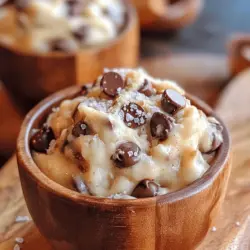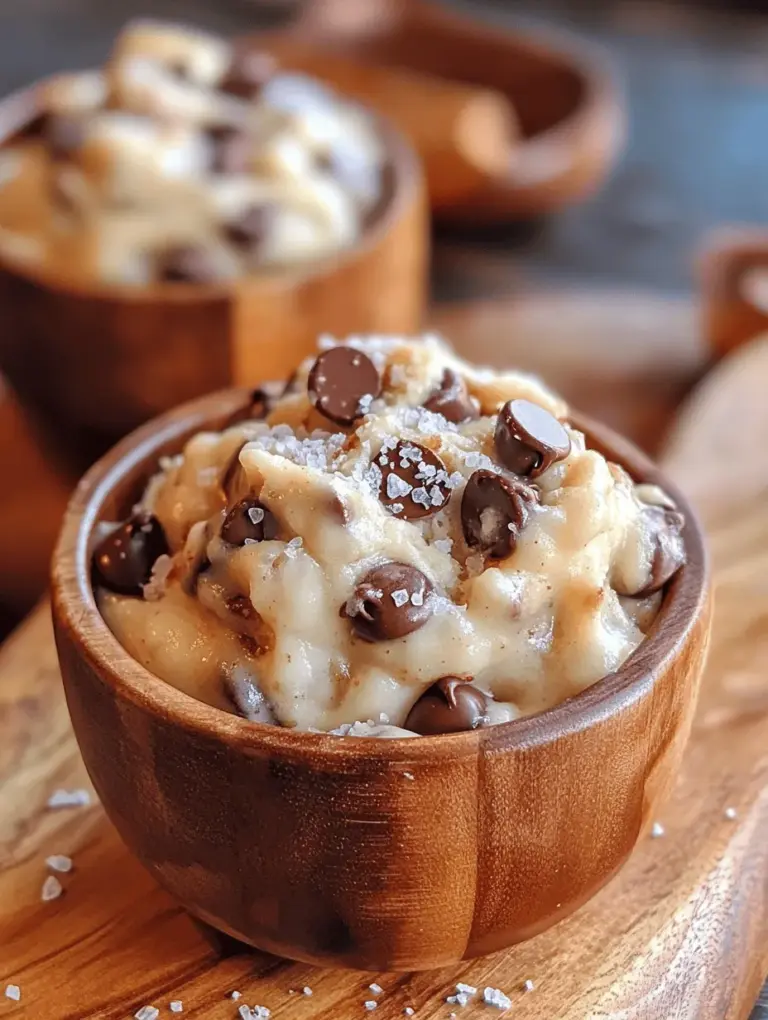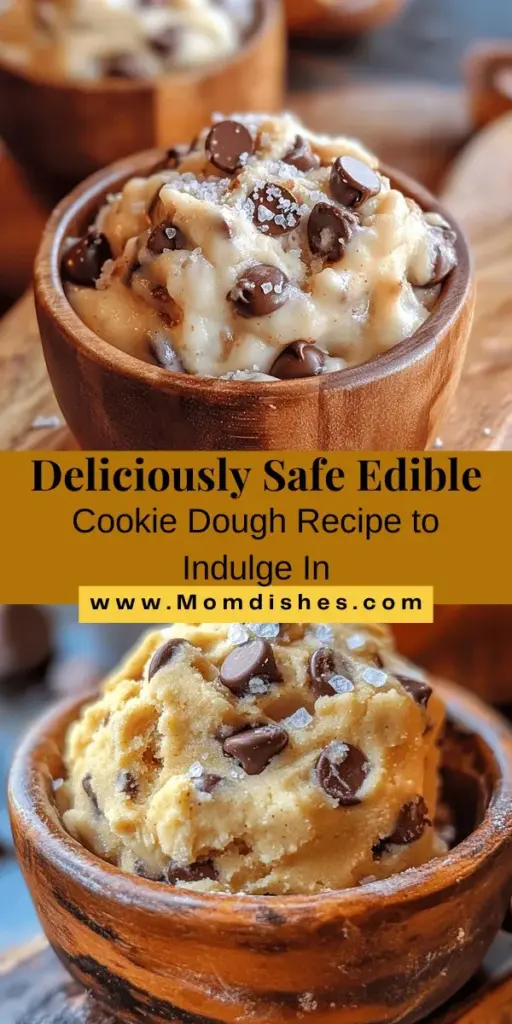Introduction
Cookie dough has long captured the hearts of dessert lovers everywhere. Its rich, sweet, and comforting flavor evokes nostalgia for many, often reminding us of warm, freshly baked cookies pulled straight from the oven. However, the traditional cookie dough recipe contains raw eggs and flour, making it unsafe for consumption in its unbaked form. This concern has led to the rise of edible cookie dough, a delightful twist that allows everyone to enjoy the flavor of cookie dough without the risks associated with eating raw ingredients.
Edible cookie dough has surged in popularity in recent years, becoming a go-to treat for all ages. Its appeal lies in its simplicity, deliciousness, and versatility, allowing for endless variations and add-ins. Whether enjoyed straight from the bowl, used as a topping for ice cream, or incorporated into desserts, edible cookie dough is a sweet indulgence that satisfies cravings without the need for baking. This easy recipe for Edible Cookie Dough Delight simplifies the process, making it accessible to everyone, from novice bakers to seasoned dessert enthusiasts.
Understanding Edible Cookie Dough
At its core, edible cookie dough is a safe version of the classic treat, designed to be enjoyed without the need for baking. The primary distinction between traditional cookie dough and its edible counterpart is the omission of raw eggs and the use of heat-treated flour. But what exactly does it mean for cookie dough to be “edible”?
The safety of consuming raw cookie dough has become a significant concern due to the risk of foodborne illnesses associated with raw eggs and untreated flour. For instance, raw flour can harbor harmful bacteria, such as E. coli, which can lead to serious health issues. To combat this, edible cookie dough recipes replace raw eggs with milk or other liquid substitutes and require heat-treated flour, rendering the dough safe to eat.
Heat treating flour is a straightforward process that involves baking it at a low temperature to eliminate potential pathogens. By ensuring the flour is safe, we can enjoy the deliciousness of cookie dough without the worry of foodborne illnesses, making it a perfect treat for parties, gatherings, or a cozy night in.
Ingredients Breakdown
Creating the perfect Edible Cookie Dough Delight involves using the right ingredients to achieve the ideal texture and flavor. Below, we’ll break down each component of this delightful treat.
All-Purpose Flour
Using all-purpose flour is essential for the structure of the cookie dough. However, it’s crucial to ensure that this flour is heat-treated. Heat-treated flour not only guarantees safety but also helps to create the right consistency for the dough. To heat-treat flour, simply spread it out on a baking sheet and bake it at 350°F (175°C) for about 5-7 minutes, stirring halfway through. This method kills any harmful bacteria, making it safe for consumption.
Unsalted Butter
Butter is a key player in cookie dough, adding richness and a delightful flavor. Unsalted butter is preferred because it allows for better control over the salt content in the recipe. When creamed together with sugars, butter contributes to a smooth, creamy texture that elevates the overall mouthfeel of the cookie dough.
Sugars
In this recipe, both granulated sugar and brown sugar are utilized, each contributing uniquely to the flavor profile. Granulated sugar provides sweetness and contributes to a crispier texture, while brown sugar adds moisture and a rich, caramel-like flavor. The combination of these two types of sugar creates a balanced sweetness that enhances the overall taste of the cookie dough.
Vanilla Extract
Vanilla extract is a must-have ingredient in cookie dough. It enhances the flavor and adds depth to the sweet notes, making the cookie dough truly irresistible. Opt for pure vanilla extract for the best flavor, as artificial vanilla can leave an aftertaste that detracts from the overall experience.
Salt
A pinch of salt is essential in balancing the sweetness of the cookie dough. Salt not only enhances the flavors but also helps to bring out the richness of the butter and sugars. It’s a small but mighty ingredient that plays a significant role in achieving the perfect flavor balance.
Milk
Milk serves as a moisture agent in this edible cookie dough recipe. By adding milk, you can adjust the consistency, ensuring that the dough is neither too dry nor too wet. This step is essential for creating a smooth, creamy texture that is easy to scoop and enjoy.
Chocolate Chips and Optional Add-ins
No cookie dough would be complete without chocolate chips! Semi-sweet chocolate chips are a classic choice, but feel free to experiment with different types, such as dark chocolate, white chocolate, or even peanut butter chips. Additionally, this recipe allows for customization with optional add-ins like chopped nuts, sprinkles, or dried fruit, making it a versatile treat that can cater to various tastes and preferences.
Step-by-Step Instructions
Now that we’ve covered the ingredients, it’s time to dive into the step-by-step process of creating your Edible Cookie Dough Delight. Follow these comprehensive instructions to ensure your cookie dough turns out perfectly every time.
Step 1: Heat Treating the Flour
The first and foremost step in making edible cookie dough is to heat-treat the flour. Preheat your oven to 350°F (175°C) and spread the all-purpose flour evenly on a baking sheet. Bake for approximately 5-7 minutes, stirring halfway through to ensure even heating. After baking, remove the flour from the oven and let it cool completely before using it in the recipe. This step is crucial for ensuring that your cookie dough is safe to eat.
Step 2: Creaming the Butter and Sugars
In a large mixing bowl, add the softened unsalted butter, granulated sugar, and brown sugar. Using an electric mixer or a whisk, cream the butter and sugars together until the mixture is light and fluffy. This process usually takes about 2-3 minutes. Properly creaming the butter and sugars is vital for achieving the right texture, as it incorporates air into the mixture, leading to a creamy and smooth dough.
Step 3: Mixing in Flavors
Once the butter and sugars are well combined, it’s time to add in the flavorings. Pour in the vanilla extract and sprinkle in the salt. Mix the ingredients until they are fully incorporated, ensuring an even distribution of flavors throughout the cookie dough. This step adds depth and richness to the dough, enhancing the overall taste experience.
Step 4: Adding Flour and Milk
Next, gradually add the cooled, heat-treated flour to the butter mixture. Mix on low speed until the flour is just incorporated. If the dough appears too thick, add milk one tablespoon at a time until you reach your desired consistency. The goal is to achieve a dough that is soft and scoopable but still holds its shape.
Step 5: Folding in Chocolate Chips and Optional Add-ins
Finally, fold in the chocolate chips and any optional add-ins you desire. Use a spatula to gently mix until the chocolate chips are evenly distributed throughout the dough. This is your opportunity to get creative and customize your cookie dough delight with your favorite flavors and textures.
By following these steps, you will have a delicious batch of Edible Cookie Dough Delight that is ready to be enjoyed as is or used in various desserts.
{{image_1}}
Combining Ingredients: Tips for Achieving the Perfect Dough Consistency
Creating the perfect edible cookie dough requires a delicate balance of ingredients to achieve that classic, creamy texture that melts in your mouth. Start by ensuring that your butter is at room temperature; this will help it blend smoothly with the sugars. When combining your dry ingredients, such as the flour, baking soda, and salt, whisk them together in a separate bowl before integrating them into the wet mixture. This step ensures that the leavening agents and salt are evenly distributed throughout the dough, preventing any unexpected bursts of saltiness.
When you mix the wet ingredients—sugar, butter, and vanilla extract—do so until they are light and fluffy. This aeration process not only enhances the texture but also improves the overall flavor. Once you combine the dry ingredients with the wet mixture, use a spatula or wooden spoon to fold them in gently. Avoid overmixing, as this can lead to a dense dough. The goal is to create a dough that is thick yet pliable. If the dough appears too crumbly, you can add a splash of milk or cream to achieve the desired consistency.
Folding in Chocolate Chips: Techniques for Even Distribution Without Overmixing
Adding chocolate chips to your edible cookie dough is where the magic truly happens. To ensure an even distribution of chocolate throughout your dough, it’s important to fold them in rather than stir vigorously. This gentle technique will help maintain the integrity of the chips while ensuring they are evenly spread.
After preparing your dough, sprinkle in the chocolate chips. Using a spatula, gently fold the chips into the dough, turning the bowl as you do so. This motion allows you to incorporate the chips without breaking them apart or overworking the dough. If you find that your chocolate chips are sinking to the bottom, you can dust them lightly with flour before adding them to the mixture. This technique creates a barrier that helps the chips stay suspended within the dough.
Adjusting Sweetness and Flavors: Encouraging Personalization
One of the most enjoyable aspects of making edible cookie dough is the ability to customize it to your taste preferences. If you prefer a less sweet dough, consider reducing the amount of sugar by 1/4 cup. Additionally, experimenting with different types of sugar can add unique flavors; for example, using brown sugar will lend a deeper, caramel-like taste to your dough.
You can also enhance the flavor profile by adding a pinch of cinnamon, nutmeg, or even espresso powder for a sophisticated twist. If you’re feeling adventurous, consider incorporating extracts such as almond or coconut for a different flavor dimension. Don’t hesitate to play around with these elements to create a cookie dough that speaks to your taste buds.
Serving Suggestions
Once your edible cookie dough is ready, the fun part begins: serving it. There are several creative ways to present this delightful treat that can elevate any gathering.
Individual Bowls for a Dessert Bar
Set up an interactive dessert bar where guests can scoop their own portions of cookie dough into individual bowls. Provide a variety of toppings like whipped cream, sprinkles, or mini chocolate chips for customization. This allows everyone to tailor their dessert to their liking, making it a hit for parties or family gatherings.
Pairing with Ice Cream or Yogurt for a Twist
For a more indulgent treat, consider pairing your edible cookie dough with a scoop of ice cream or a dollop of yogurt. The creaminess of the ice cream complements the texture and flavor of the cookie dough beautifully. You can even create a cookie dough sundae by layering ice cream, cookie dough, and your favorite toppings for a decadent dessert that everyone will love.
Using as a Filling for Crepes or Pastries
Another unique serving suggestion is to use the edible cookie dough as a filling for crepes or pastries. Simply spread a thin layer of cookie dough inside a warm crepe, roll it up, and drizzle with chocolate sauce or a dusting of powdered sugar. This creates a delightful dessert that combines the best of both worlds.
Storage Tips
To keep your edible cookie dough fresh and delicious, proper storage is key.
Best Practices for Storing Edible Cookie Dough
Store your cookie dough in an airtight container. This prevents it from drying out and keeps it flavorful. If you plan to consume the dough within a few days, it can be kept in the refrigerator. However, if you want to extend its shelf life, freezing is the way to go.
Shelf Life in the Refrigerator and Tips for Freezing
When stored in the refrigerator, edible cookie dough will typically stay fresh for about 5-7 days. For longer storage, consider freezing the dough. Scoop the dough into balls and place them on a baking sheet lined with parchment paper. Freeze until solid, then transfer the dough balls to a freezer-safe bag or container. Frozen cookie dough can last for up to three months.
To use frozen dough, simply remove it from the freezer and let it thaw in the refrigerator for a few hours before serving. This makes it convenient to have on hand for spontaneous cravings or surprise guests.
Recommendations for Using Leftover Dough in Other Recipes
If you find yourself with leftover cookie dough, don’t let it go to waste! You can incorporate it into various recipes. Crumble leftover dough over ice cream for a delicious topping, or mix it into pancake batter for a fun breakfast treat. Edible cookie dough can also be used as a filling for brownies or cookies, offering a delightful surprise in every bite.
Nutritional Information
While edible cookie dough is undeniably a treat, it’s important to be mindful of its nutritional aspects.
Overview of the Nutritional Aspects of the Recipe
A typical serving of edible cookie dough may contain a moderate amount of calories, primarily from sugars and fats. However, it also provides a small amount of protein from the flour and butter. By adjusting the ingredients—such as using less sugar or incorporating healthier fats—you can create a version that aligns better with your dietary goals.
Discussion on Portion Control and Indulgence
The key to enjoying edible cookie dough is moderation. While it can be tempting to indulge, practicing portion control is essential. Consider serving smaller portions to satisfy your sweet tooth without overdoing it. This way, you can enjoy the deliciousness of your treat while keeping your dietary habits in check.
Variations and Customizations
Endless possibilities await when it comes to customizing your edible cookie dough recipe.
Ideas for Customizing the Recipe to Suit Different Tastes
You can easily tailor your cookie dough to suit various preferences. For a nutty flavor, consider adding finely chopped hazelnuts, walnuts, or pecans. The crunch and richness of these nuts can elevate your treat to another level.
Alternative Mix-Ins: Sprinkles, Dried Fruit, or Candy Pieces
In addition to chocolate chips, you can incorporate other delicious mix-ins. Try adding colorful sprinkles for a festive look, or toss in some dried fruit like cranberries or apricots for a chewy texture. If you’re in the mood for something extra sweet, candy pieces such as M&Ms or Reese’s Pieces can add a fun twist.
Dietary Substitutions: Gluten-Free Options and Plant-Based Alternatives
For those with dietary restrictions, it’s easy to adapt this recipe. Substitute regular flour with gluten-free flour to create a gluten-free version of your edible cookie dough. Additionally, you can use plant-based butter and dairy-free chocolate chips to accommodate a vegan lifestyle. These substitutions allow everyone to enjoy this delightful treat without compromise.
Conclusion
Making edible cookie dough is not just about satisfying a craving; it’s an enjoyable process that invites creativity and personalization. The ease of preparation combined with the joy of customization makes this recipe a favorite among dessert lovers. Whether served in individual bowls, paired with ice cream, or wrapped in a crepe, edible cookie dough offers endless opportunities for enjoyment.
As you experiment with flavors and serving methods, remember to indulge responsibly and share your creations with loved ones. After all, the joy of food is best experienced when shared. So gather your ingredients, unleash your creativity, and delight in the deliciousness of easy edible cookie dough!


